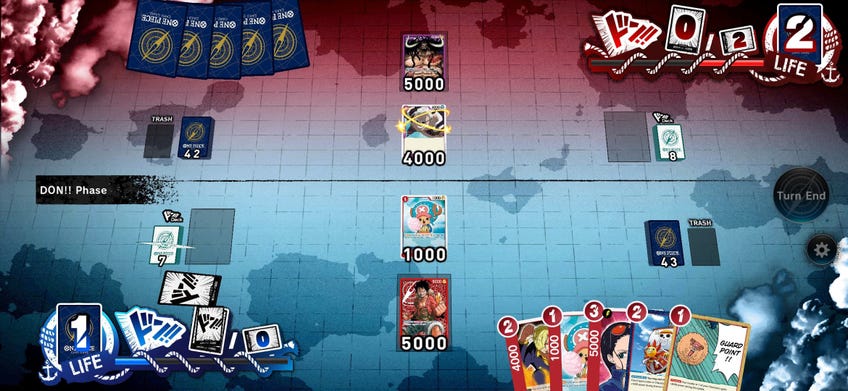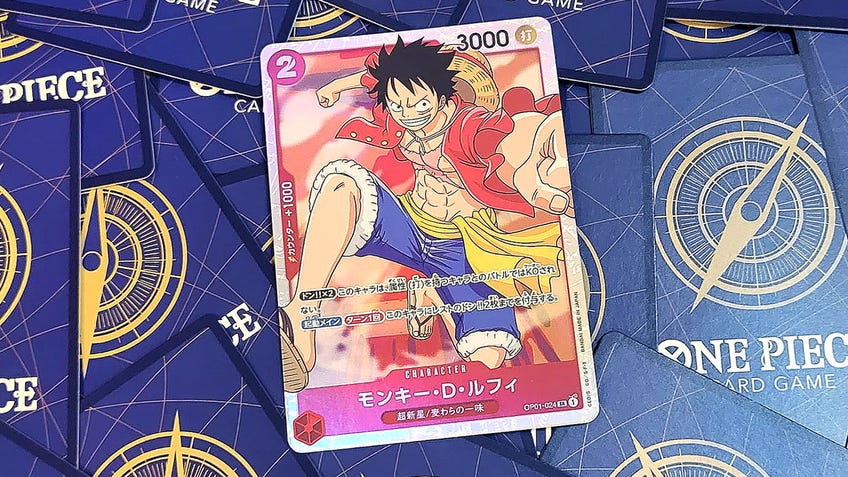Why you should be paying attention to the One Piece Card Game
Gol D. Star.
It’s been an excellent year to be a One Piece fan. The long-running pirate voyage manga has reached a point of all-time popularity, wrapping up a five-year-long story arc and beginning the final saga, where decades of world-building and mysteries are expected to be resolved before the series’ much anticipated conclusion.
In 2022, One Piece has also continued to assert itself as a multimedia franchise, dominating the Japanese box office with One Piece Film: Red, gearing up for a Netflix adaptation and - perhaps most excitingly - throwing its straw hat into the ring of licensed trading card games. At the height of One Piece’s success, we’ve finally gotten a tabletop experience that offers a small slice of the joy that Strawhat Pirates have been bringing to the page and screen over the last 25 years.
In July, the One Piece Card Game launched in Japan. Since then, it’s maintained a meteoric popularity in the Japanese retail market. In playing the game since this launch, both with the pre-constructed starter decks and constructed decks, it’s easy to come to terms with what the game is, but also what it has the potential to be.
At the time of writing, the English version of the game has released a ‘super pre-release set’ of starter decks to get started, with the first booster set and additional decks releasing later in the year. Those looking to try out the game can also start learning it with the free tutorial app on mobile, which teaches the basics of play across a few games using the starter decks.
Although clearly inspired by other games of its kind, the uniquenesses of the One Piece Card Game shine through.
More than a mere cash grab, the One Piece Card Game may share a lot of DNA with its licensed card game contemporaries, but it also shows a clear devotion to growing into a unique identity and doing justice to the rich universe it’s based on. Although clearly inspired by other games of its kind, the small uniquenesses of the One Piece Card Game shine through in this melting pot of old ideas.
One Piece Card Game offers a very familiar structure if you’ve ever played a modern trading card game. Players take turns building a pirate crew and battling their opponent in an attempt to bring their rival’s life points down to zero to claim victory. These life points are determined by a ‘leader’ card that acts as your primary target when there are no other cards on the field.

Perhaps unsurprisingly, the currently available leader cards are also the most important characters of the One Piece world, with passive effects that add a bit of extra flavour to each matchup. These leader cards often capture the essence of major characters in gameplay - such as protagonist Monkey D. Luffy’s unyielding devotion to his friends, which in card game terms powers up all his comrades with a bounty of additional resources.
The nature of the leader system also lends One Piece Card Game another layer of strategy, as your leader will frequently need to pop in and out of safety to do battle themselves, not unlike Magic: The Gathering’s Commander format. As your leader can often easily become your most powerful offensive card, there’s also an enthralling risk/reward element to using their skills at exactly the right moment without exposing them to too much danger.
As your life points tick down, you can flip facedown cards representing each life point to your hand - if the card drawn has a 'trigger' effect, this can be activated immediately to shake things up. This works a lot like the recent Digimon Card Game’s security system, in the way that it can occasionally spring interesting traps on your opponent as you’re losing health, often making damage-dealing just as suspenseful for the one dealing damage as the one receiving it. These triggered effects will almost always cause an amusing backfire, with the most lethal abilities coming from the game’s ‘event’ cards, which reference specific iconic moments from the story.

Playing cards in the One Piece Card Game relies on a gradually increasing resource pool. These are called ‘Don!!’ cards, named after the onomatopoeia used frequently in the original manga to indicate action or excitement. As the manga uses this onomatopoeia with comical frequency, it’s appropriate that ‘Don!!’ is equally prevalent in the card game.
Don cards are one of the more compelling elements of the game, forcing players to make difficult tactical decisions with their limited resources.
Don cards are one of the more compelling elements of the game overall, forcing players to make difficult tactical decisions in the allocation of their limited resources. They can be used to boost the power of any character on the field, but are also the only way to get cards from the hand to the field. In addition, many temporary card effects can only be activated by feeding a character card a certain amount of Don cards, which will inevitably lead to some tough decisions.
The One Piece Card Game relies on a colour system that determines which leader characters can be paired with which cards, and the general ‘vibe’ of related card effects. It’s a lot less coherent than Magic: The Gathering’s mana colours, but it works as intended: constructing your deck around one or two colours will certainly develop some kind of theme.
One Piece Card Game offers some unique ways to play, with classic control abilities that freeze up card effects or more aggressive styles that focus on card removal. One Piece Card Game seems to be aware that many characters in One Piece are disruptive, tricky miscreants (they’re pirates, after all) with access to unusual powers. As a result, many card effects reflect the zany reality of the One Piece world.
In its current incarnation, especially when you get into the detail of building your own deck, One Piece Card Game is an entertaining play experience, even if it is a little basic. Play sessions are often short and, because the current pool of cards is relatively small, there is a limited variety in what can be experienced at the moment. However, the One Piece Card Game offers a solid gameplay foundation that can undoubtedly be expanded upon in later set releases.
In spite of these solid gameplay foundations, the One Piece Card Game may still become more popular with collectors than players, thanks to the remarkable consistency and quality of its art design. Using a combination of sleek graphics, existing character artwork and a selection of original pieces by series creator Eiichiro Oda, One Piece Card Game pulls everything together with some impressive visuals that complete the package.
The One Piece Card Game is doing a lot of work to build the definitive card game based on the iconic series. Whilst it could certainly benefit from additional mechanical complexity, more cards and tools to help adjust the pace (at the moment, games move very quickly), many of these problems are indicative of its infancy. If it’s given the same care as the rest of the franchise has had recently, it certainly has an exciting future ahead.



